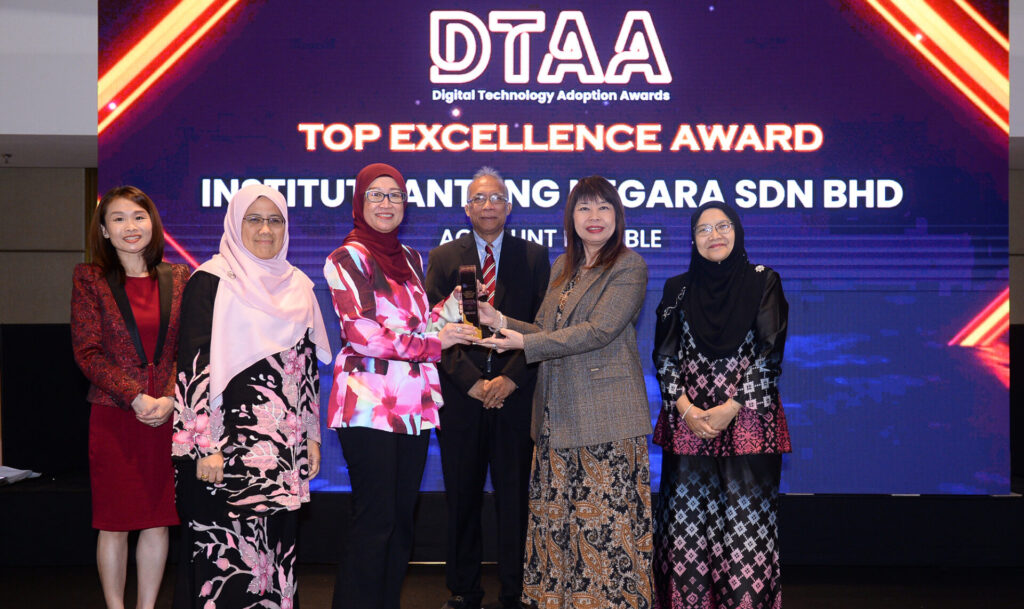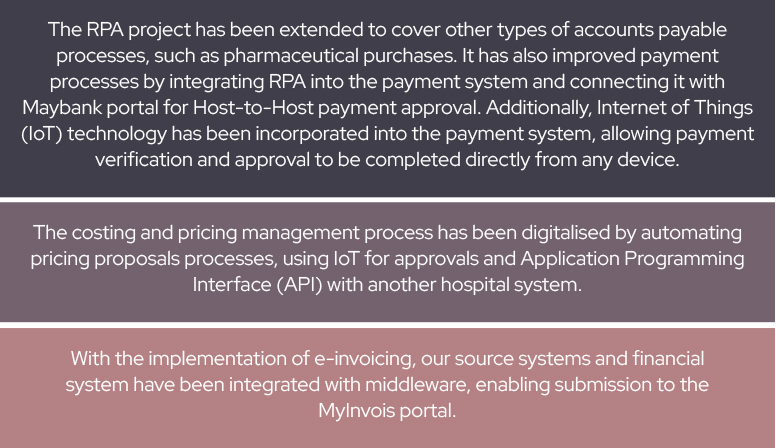By MIA Sustainability, Digital Economy and Reporting Team
In recognising digital technology adoption efforts and promote digital technology adoption by the accountancy profession, the Malaysian Institute of Accountants (MIA) organised the inaugural Digital Technology Adoption Awards (DTAA). Fourteen outstanding winners were celebrated at the prestigious DTAA Presentation Dinner on 15 May 2024, following an intense and rigorous adjudication process that highlighted their exceptional achievements in digital technology adoption.

In this series of the DTAA Winners in Action, we take a closer look at Institut Jantung Negara Sdn Bhd and their journey to becoming the recipient of our ‘Top Excellence Award’ for the Accounts Payable process in the non-listed entities of the Commerce & Industry category. Join us as we uncover the technology adoption that has distinguished them from others, paving the way for their exceptional success in digital transformation and setting a new standard of excellence.
Why did you adopt technology?
The decision to adopt technology was primarily driven by a range of significant challenges that the organisation was facing at the time which include the following:
- Delayed payment to suppliers and recognition of expenses become daily and monthly issues for accounts payables processing and financial reporting.
- Delayed receipt of suppliers’ invoices and loss of documents due to transfer and exchange of paper documents between functional departments and vendors became apparent with voluminous transactions.
- Staff morale and the work environment were stained with arguments due to mismatched understanding of role and responsibilities.
What technologies have you adopted?
Digital technologies used in addressing the pain points above combined Robotic Process Automation (RPA) with the current financial system and Microsoft applications. The key technologies adopted were Systems, Applications and Products Intelligent Robotic Process Automation (SAP iRPA), which seamlessly integrates with SAP Business Suite 4 for High-Performance ANAlytic Appliance (SAP S/4HANA) and Microsoft Office applications.
SAP iRPA leverages Artificial Intelligence (AI) and Machine Learning (ML) to automate data extraction from Portable Document Format (PDF) invoices. This process was enhanced with the following capabilities:

How was your digital technology implementation journey?
Our focus was primarily on specific areas that significantly contributed to the pain points in the accounts payable process, as well as areas that could potentially yield high impact opportunities for improvement (OFI) across other business processes. Identifying key stakeholders, securing their buy-in, and streamlining both the “As-Is” and “To-Be” processes were integral to the successful adoption of digital technology.
Confidence in the solution’s ability to improve efficiency was crucial for gaining support from all stakeholders and managing changes smoothly in the affected areas. Securing management support and approval for investment was essential, especially since the technology being adopted is largely invisible. Justifying the involvement of external parties, such as vendors, was also important. Clear agreements had to be reached with vendors, especially when it comes to process changes like digital invoicing, to ensure the project’s requirements were met.
Assembling the right project team was also vital to the success of the digital transformation. Staff willingness and commitment to embracing new ways of working, with a clear focus on continuous process improvement, were key drivers of success. Selecting the right vendor and project team was equally important for both the implementation and the long-term sustainability of the digital technology adoption. Aligning the team and the vendor on the project’s objectives and long-term goals was essential to ensure the continued success and sustainability of digital transformation.
Lastly, project timelines and charters were agreed upon upfront to meet the required milestones. Any issues that arose during the project, depending on their impact and urgency, were addressed and resolved with the involvement of a Steering Committee. This approach ensured proper governance, especially when dealing with scope changes or additional investments.
What is the impact of your technology adoption?
- Efficient and effective consignment invoices and payment processing has resulted in timely recognition of consignment cost at any reporting period. There were no further internal control issues on accounts payables being highlighted by the external auditor since the adoption of the project in the year 2020.
- Cost savings in human capital were realised by maintaining the same number of Full-Time Equivalents (FTEs) despite an increase in transactions. In the fourth year of adoption, this resulted in a saving of six FTEs (i.e., an estimated RM154,000 per year).
- Cost savings in terms of paper usage and printing cost, estimated at RM30k per year.
- Increased staff morale following the completion of the project, fostering a culture of continuous process improvement and boosting confidence among staff initiating new technology adoption projects.
- Improved staff working environment in the department and cross departments resulting from the re-aligned and defined processes. With the process of automation, combined with laptops (previously, staff is only equipped with desktop), staff was enabled to work remotely whenever needed.
What is your future digital technology plan?
We have embarked on the following adoption of digital technology to enhance our processes:

Do you have any tips to share with the readers?
Build the right team for digital transformation
To successfully lead a digital transformation, an organisation needs a team with the right skills and competencies.
Digital transformation: More than just technology
Digital transformation is not limited to the adoption of technology; it requires a cultural shift within the organisation. This shift should focus on delivering value to customers and stakeholders while fostering a mindset of continuous improvement.
Align technology adoption with strategic blueprint
The adoption of digital technologies should align with the organisation’s Strategic Blueprint. This ensures that technological investments are in line with the company’s overall goals and objectives.
Conduct an Information Technology (IT) inventory audit
Before starting any major IT adoption project, it is important to conduct an IT inventory audit. This audit will assess the current capabilities of the organisation’s systems and help identify any gaps or areas that need improvement before moving forward with technological adoption.

Take a holistic view of business processes
A holistic approach should be taken when assessing the business processes that will be affected by the technological change. This ensures that all impacted areas are considered and that the transition is as smooth and efficient as possible.
Ensure success through management support and change management
Management support and effective change management are crucial to the success of any digital transformation project. Selecting the right team for implementation, ensuring clear communication, and engaging key stakeholders will ensure that the project progresses smoothly and delivers the intended results.
Learn from past experiences
Reflecting on past experiences can offer valuable lessons. For instance, in adopting RPA, a more integrated approach to processes such as accounts payable could have led to more significant improvements and cost savings. Leveraging existing knowledge from the Management Information System (MIS) and Finance teams can further enhance future projects.
Measure success beyond ROI
While Return on Investment (ROI) is a common metric for evaluating technology adoption, it’s not the sole indicator. The impact of digital technologies is often indirect and qualitative, with a focus on improving user experience, customer satisfaction, and ensuring roles and responsibilities are effectively fulfilled across the organisation.
Why did you participate in the DTAA?
We participated in this initiative to share our journey and experiences in adopting digital technology within the specific area of Accounts and Finance. Our aim was also to provide exposure to the IJN team, showing them that they are not alone in embracing digital technology in their work processes. Additionally, we hoped to learn from others by understanding their challenges, experiences, and the areas they have focused on in their technology adoption initiatives. The DTAA has taught us to consider every aspect of an IT investment, from the project’s initiation to its long-term sustainability. Ultimately, it confirms that technology adoption has a meaningful impact, not only to the organisation but also to the country as a whole.
What is your advice to aspiring participants of the DTAA in the future?
We advise future participants to start small with the digital technology adoption and persevere in seeking out for more projects. Digital technology adoption is part and parcel of continuous process improvement, and its sustainability should be given significant consideration.
For more information about the DTAA and the complete list of winners, click the links below:







